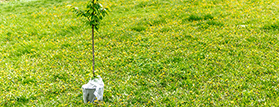Friday, April 29, 2022, is Arbor Day, a national holiday to encourage people to plant and nurture trees. This annual holiday, which started in 1872, was the brainchild of Julius Sterling Morton, President Grover Cleveland’s Secretary of Agriculture.
One of the best ways to celebrate Arbor Day is to plant a tree. To get involved, you might find some non-profit groups in your area offering volunteer opportunities and some corporations may also organize tree planting events.
The Value of Trees
Trees are an important part of the ecosystem that provide food and shelter for animals and birds and add beauty to any area where they are allowed to grow and thrive. People simply love trees, and they have a positive effect on our moods and mental health.
Trees are also critical in combating climate change. They eat up air pollution and CO2 and replace it with life-giving oxygen. They reduce surface heat by providing shade, which is necessary in hot cities where pavement and buildings can create dangerous “urban heat islands.”
With all these benefits, trees also boost home and property values, making them an investment that provides tangible dividends.
Tips on Planting Trees
Planting trees is not overly difficult, but do not underestimate the care and planning that should go into your tree-planting venture. Here are a few things to consider when planting trees:
What Will You Plant and Where?
While it takes years for a tree to grow to its full height and width, keep the final size in mind when choosing what to plant and where. You’ll want a tree that doesn’t crowd out the other trees in the vicinity, or worse, grow dangerously close to a roof, power lines or other structures.
The type of tree you plant should be one that can thrive in your regional climate. Ideally, this will be a tree that is native to the area. Bringing in exotic trees could impact the ecosystem, including the insects, although it is now common to plant non-native palm trees in states like Florida and California. Both states have their own native palm trees, but in Southern California, only one palm tree is native, the Washingtonia filifera, and in Florida, many palm trees are becoming endangered due to development.
Palm trees guzzle water to survive, and other types of trees do as well, so keep this in mind when choosing a tree. You don’t necessarily want to plant a palm tree in an arid area where water is scarce unless you plan on watering it regularly.
Taller trees also need more water in general. Hot and dry areas like central Texas tend to have shorter trees because of the lack of water and excess heat.
Selecting a Tree
The best way to shop for a tree native to your area is, of course, locally. Your local nursery should have a variety of trees to choose from. A smaller, younger tree is a wiser choice for planting because larger, more mature trees often need to have their roots cut for transportation. Keeping the roots intact will give your tree a greater chance at success. This is not to say you cannot start with a larger tree, but it may need some additional care.
Preparing the Area for Planting
Once you have selected your tree and the general location, you’ll need to dig a hole. The hole will initially also be a testing hole. You should fill it with water before planting the tree, and if you notice any issues with drainage, the ground in that spot may not be suitable or you may need to consult with a professional landscaper.
The hole for your tree should be two to three times the size of the root ball of the tree.
Planting the Tree
To plant, place the tree’s root ball carefully in the hole and then fill the hole with dirt. Make sure the dirt is even around all sides and that the tree is secured in the middle. The dirt should be tamped down firmly but not packed so tightly that the roots can’t breathe. The tree should be stable in the dirt and not tipping over.
Water the tree immediately after planting. You should use enough water to make the soil moist but not too soggy.
Once the Tree is Planted
After planting, watering is one of the most important things you’ll need to do for your new tree. Depending on the tree, you might end up using five to ten gallons per week or more. Fertilizer for your tree can help it grow, especially if the soil in your area is depleted.
Mulching around the tree can also be helpful, but only if done correctly. Never place mulch directly against the tree’s trunk. This could trap moisture and cause the wood to decay. Mulch should be spaced at least three inches away from the tree trunk.
Finally, don’t forget pruning. Young trees will grow many branches that are in competition for one another as the top dog, but this can weaken the tree. Strategic pruning is the key to a healthy, strong, thriving tree for years to come.
Townsend Tree places a high value of trees. We take the utmost care to carefully trim and maintain trees to support their health while keeping branches away from critical power lines. Contact us today for more information on how we can keep energy systems up and running through smart vegetation management—or, reach out to our sister company, Townsend Arborcare, for help maintaining your residential tree needs.
